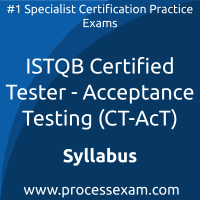 To achieve the professional designation of ISTQB Certified Tester Acceptance Testing from the ISTQB, candidates must clear the CT-AcT Exam with the minimum cut-off score. For those who wish to pass the ISTQB Acceptance Testing certification exam with good percentage, please take a look at the following reference document detailing what should be included in ISTQB CT - Acceptance Testing Exam preparation.
To achieve the professional designation of ISTQB Certified Tester Acceptance Testing from the ISTQB, candidates must clear the CT-AcT Exam with the minimum cut-off score. For those who wish to pass the ISTQB Acceptance Testing certification exam with good percentage, please take a look at the following reference document detailing what should be included in ISTQB CT - Acceptance Testing Exam preparation.
The ISTQB CT-AcT Exam Summary, Sample Question Bank and Practice Exam provide the basis for the real ISTQB Certified Tester - Acceptance Testing (CT-AcT) exam. We have designed these resources to help you get ready to take ISTQB Certified Tester Acceptance Testing (CT-AcT) exam. If you have made the decision to become a certified professional, we suggest you take authorized training and prepare with our online premium ISTQB Acceptance Testing Practice Exam to achieve the best result.
ISTQB CT-AcT Exam Summary:
| Exam Name | ISTQB Certified Tester Acceptance Testing |
| Exam Code | CT-AcT |
| Exam Fee | USD $199 |
| Exam Duration | 60 Minutes |
| Number of Questions | 40 |
| Passing Score | 26 / 40 |
| Format | Multiple Choice Questions |
| Schedule Exam | Pearson VUE |
| Sample Questions | ISTQB CT - Acceptance Testing Exam Sample Questions and Answers |
| Practice Exam | ISTQB Certified Tester - Acceptance Testing (CT-AcT) Practice Test |
ISTQB Acceptance Testing Syllabus Topics:
| Topic | Details |
|---|---|
Introduction and Foundations - 80 mins. |
|
| Fundamental Relationships |
- Recall the relationship between business goals, business needs and requirements - Explain the relationship between requirements / user stories, acceptance criteria and acceptance tests - Explain how the quality of requirements / user stories and acceptance criteria affects acceptance testing |
| Business Analysis and Acceptance Testing |
- Summarize the relationship between acceptance testing activities and business analysis activities - Explain how testers and business analysts collaborate in acceptance testing activities - Describe Acceptance Test-Driven Development (ATDD) and BehaviorDriven Development (BDD) |
Acceptance Criteria, Acceptance Tests and Experience-Based Practices - 165 mins. |
|
| Writing Acceptance Criteria | - For a given requirement or user story, develop a set of acceptance criteria that meet good practices |
| Designing Acceptance Tests |
- Explain test approaches and test techniques for acceptance testing - Apply the Gherkin language for designing acceptance tests for a given user story |
| Experience-based Approaches for Acceptance Testing |
- Summarize how exploratory testing can be used for acceptance testing - Summarize the relationship between beta testing and acceptance testing |
Business Process and Business Rules Modeling - 150 mins. |
|
| Modeling Business Processes and Rules | - Construct a simple business process/rule model* using BPMN and/or DMN notations |
| Deriving Acceptance Tests from Business Process/Rule Models | - Derive a set of acceptance tests covering a given coverage criterion from a given, simple business process/rule model* (in BPMN or DMN) |
| Business Process Modeling for Acceptance Testing |
- Summarize the good practices of business process and business rule modeling for acceptance testing - Explain how business process and business rule modeling can be used for ATDD |
Acceptance Testing for Non-Functional Requirements - 95 mins. |
|
| Non-functional Characteristics and Quality in Use |
- Give examples of ISO 25010 non-functional sub-characteristics that should be considered in acceptance tests - Recall quality in use characteristics according to the ISO 25010 standard |
| Usability and User Experience |
- Relate different types of usage scenarios to the four pillars of UX requirements analysis - Summarize different methods for testing usability within the respective domains of application |
| Performance Efficiency |
- Explain high-level performance tests according to given efficiency requirements - Recognize the impact of different perspectives on performance acceptance criteria |
| Security | - Explain why security acceptance criteria and related high-level security tests are required for a project in accordance with a given security requirement |
Collaborative Acceptance Testing - 110 mins. |
|
| Collaboration | - For a given situation, apply social and communication skills relevant for collaborative acceptance testing activities |
| Activities |
- Explain how to analyze discrepancies between actual and expected outcomes at the business level in a given context - Summarize reporting activities for acceptance testing for stakeholders - Explain different QA techniques for acceptance testing activities |
| Tool Support | - Recall scope and objectives of tool support for acceptance testing activities |
Both ISTQB and veterans who’ve earned multiple certifications maintain that the best preparation for a ISTQB CT-AcT professional certification exam is practical experience, hands-on training and practice exam. This is the most effective way to gain in-depth understanding of ISTQB CT - Acceptance Testing concepts. When you understand techniques, it helps you retain ISTQB Acceptance Testing knowledge and recall that when needed.
